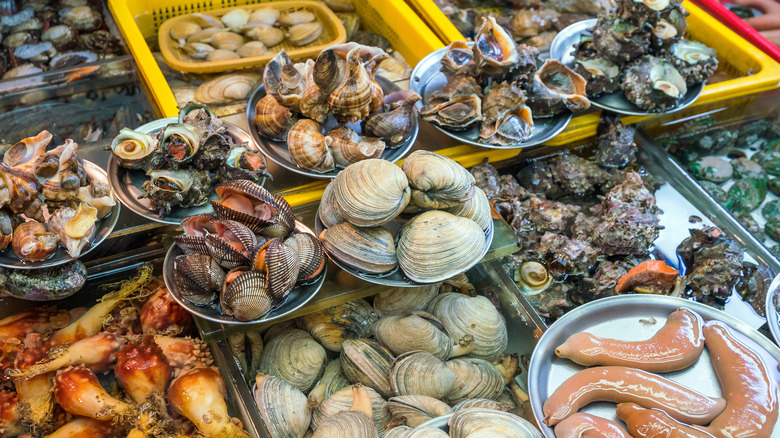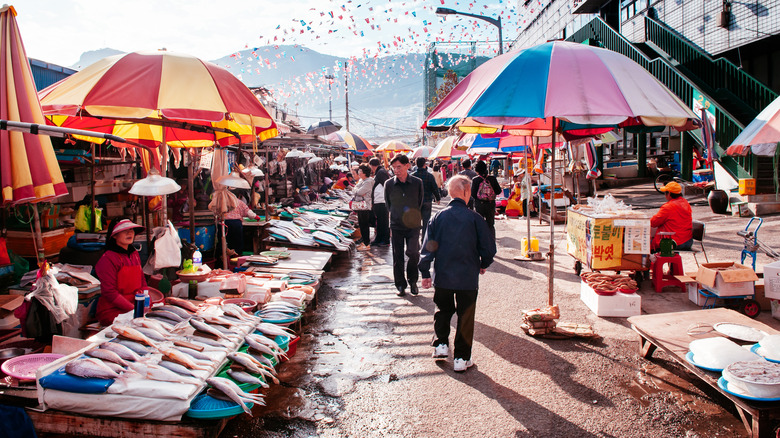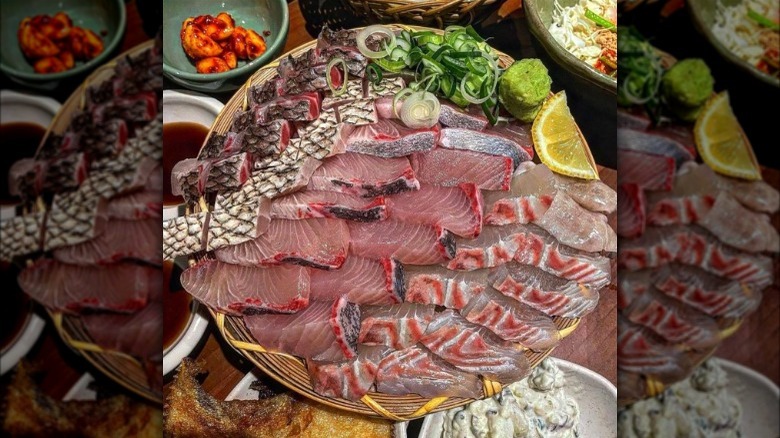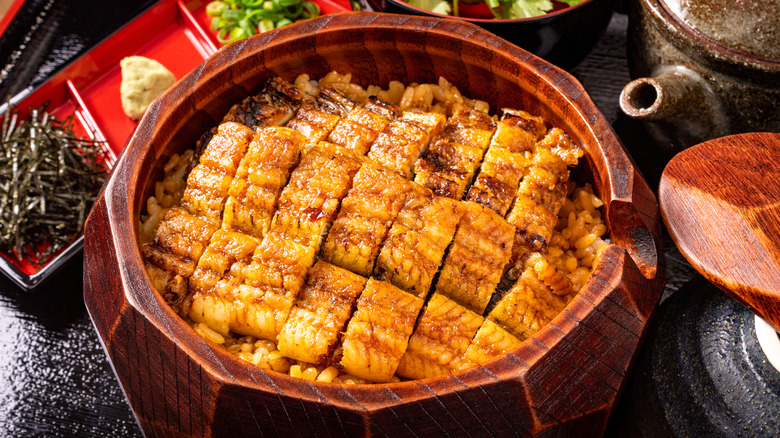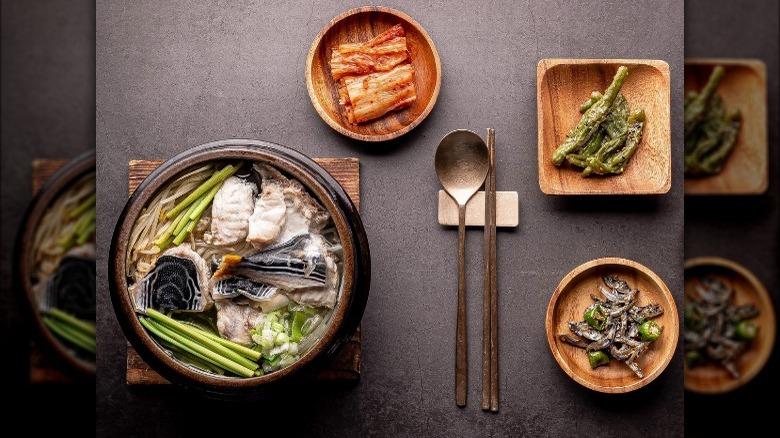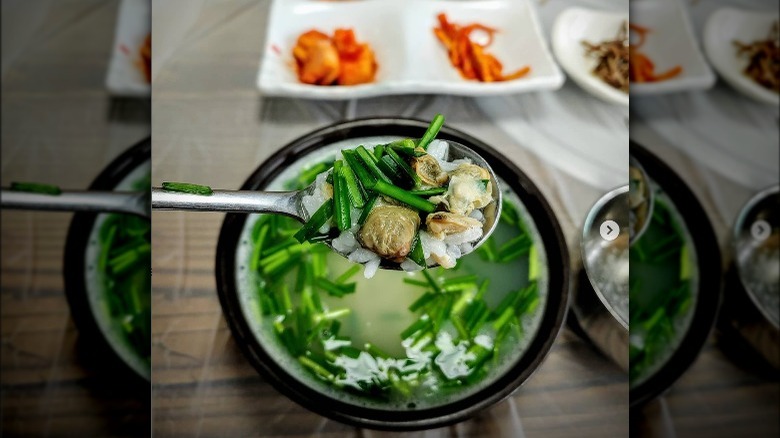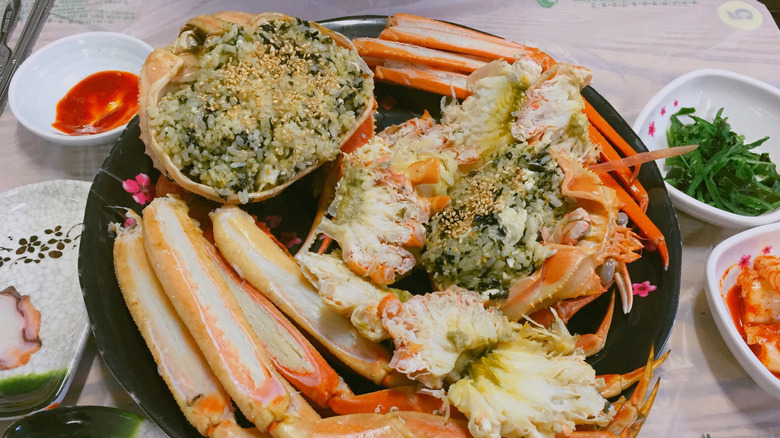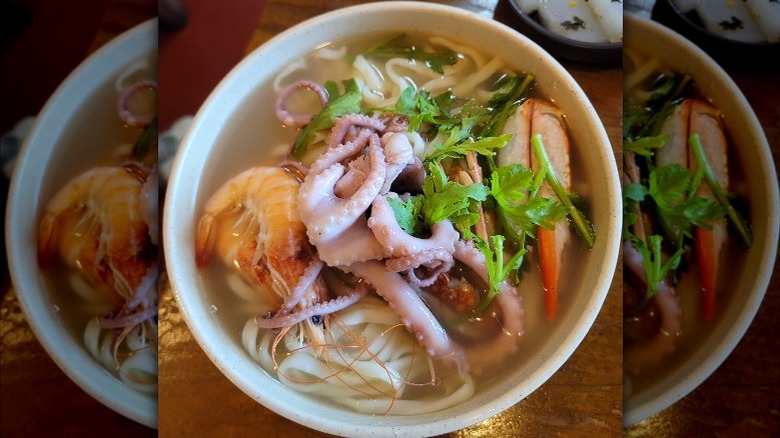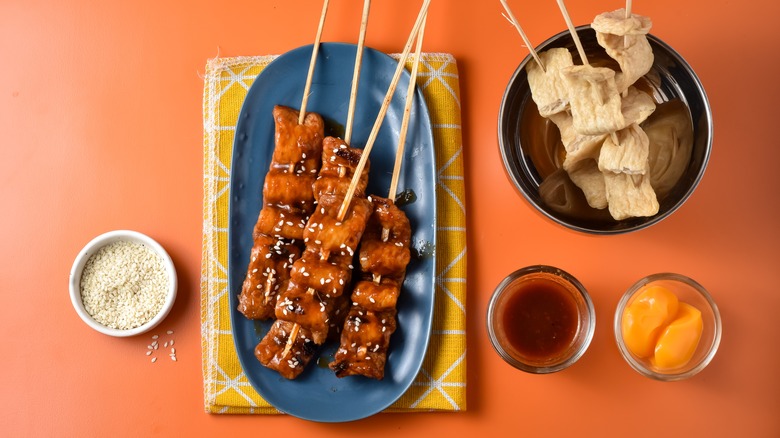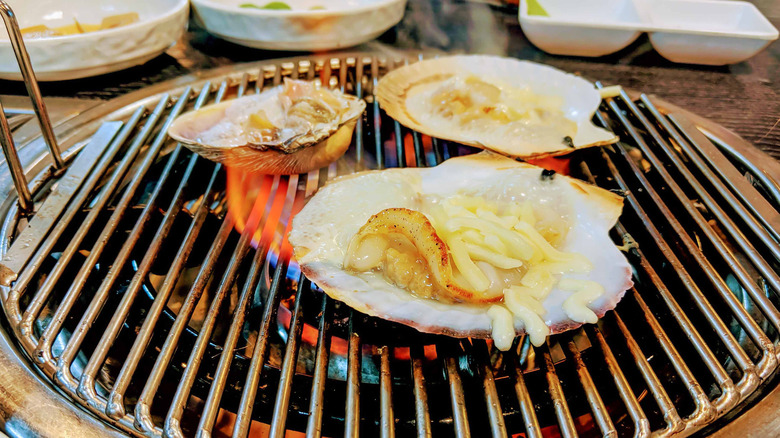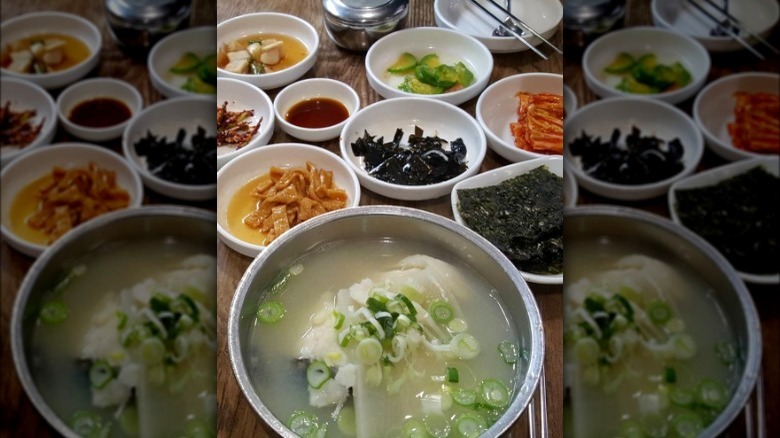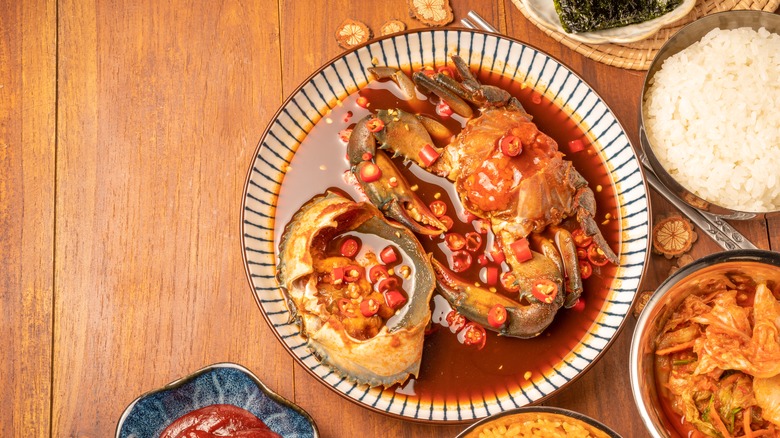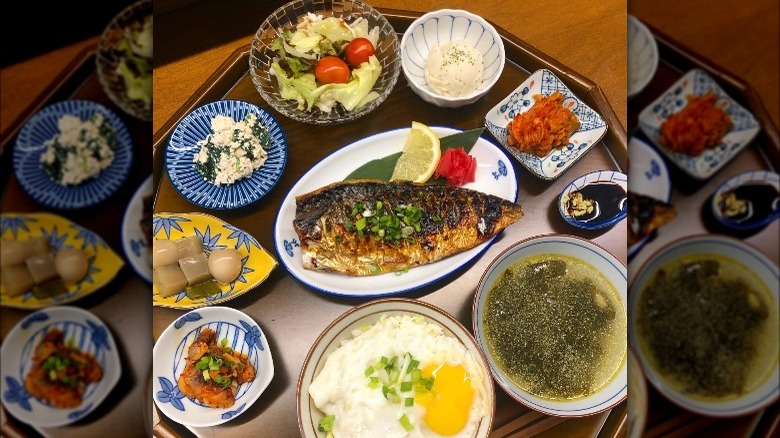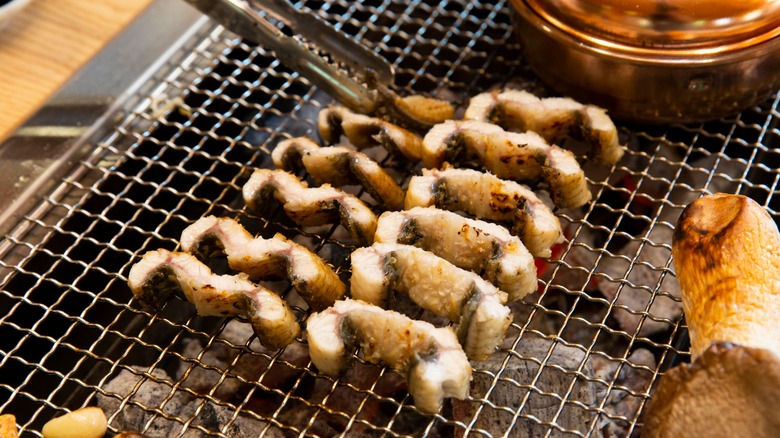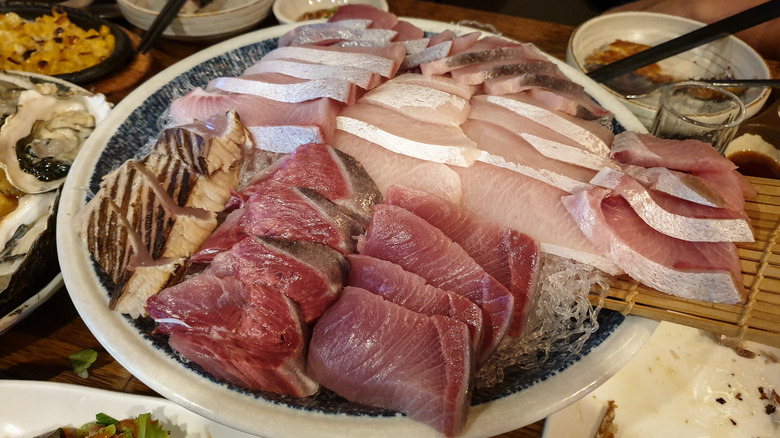14 Absolute Best Seafood Restaurants In Busan, South Korea
When you think of Korean food, seafood may not be the primary thought. Banchan side dishes like kimchi or mains like fried chicken, bulgogi, or Korean BBQ probably come to mind. But, Korean food is rich with many seafood options, which makes sense when considering the country geographically. It's surrounded by water on three sides, and South Korea has nearly 1,500 miles of coastline (via World Data).
Seoul is the most populated city in South Korea, followed closely by Busan, a city that's especially rich in seafood because of its location in the southeastern region on the water. A Seoul resident, who visits Busan, told us that Navar Maps (the Korean equivalent of Google Maps) is the best way to find restaurants while in the country. To narrow down the list of options, you might focus on two main areas for seafood — Gwangalli Beach east of the city center or the more populous Haeundae district — but the city is easy to navigate by bus, and you can find great food all over.
After searching through online reviews and first-hand accounts, we narrowed down the absolute best seafood restaurants in Busan, South Korea. Here's where they are and what you should order when you visit.
Jagalchi Market
Jagalchi Market is located on the edge of Nampo Port and is home to South Korea's Largest Fish Market. It starts serving its first customers at 5 a.m. when many shop the market like a grocery store. It can also be enjoyed as a restaurant by choosing from the fresh seafood on the first floor — fish, clams, mussels, crabs, shrimp, octopus, and more — and asking for it to be prepared at a restaurant on the second floor. If that feels too overwhelming, you can also go to a restaurant first and choose from a menu inspired by the day's catch.
When it comes to specific restaurants, two names stand out when pouring through Jagalchi Market's reviews: Haewangsanghae at kiosk number 97 and Jacky's Seafood. In addition to the fresh seafood, you can expect to receive a variety of pickled and fermented vegetables on the side, dishes referred to as banchan.
Choembeong
This seafood restaurant in Gwangalli Beach specializes in raw fish, similar to Japanese sashimi. Saengseon-hwe is sometimes spelled "hoe" but pronounced "hwae." According to Dokkaebi, Korean sashimi is fundamentally different because of the availability of fish in Korea. The Japanese islands block Korea from the Pacific Ocean, limiting their access to certain fish species while simultaneously increasing the availability of fish that can live in tanks. That means the fish will remain alive and fresh until the moment you select it, giving Korean saengseon-hwe a firmer texture that's chewier compared to the softer, meltier textures of Japanese sushi.
Choembeong offers numerous gorgeous platters that make our mouths water at first sight. The raw fish is sliced thick and layered in different assortments to create a colorful display, and it's shown with sides of hot mustard, wasabi, soy sauce, and gochujang (a Korean red chili paste) as a dipping sauce. The restaurant also serves noodles and other cooked fish preparations in addition to raw options, so this is a good place to stop even if you can't see yourself eating sashimi.
Haemok
If you've come to Busan to celebrate Korean food, you might want to skip past this recommendation. But, if you're interested in the best seafood in Korea — regardless of the style of cuisine — make sure to include this Haeundae Beach restaurant on your list. Korea By Me describes the restaurant as one of the more high-end establishments in the area. That said, the portions are generous, and the menu provides a comprehensive list of options for trying several different Japanese dishes.
The restaurant has thousands of positive reviews for its raw and fresh fish preparations. The menu features a freshwater eel dish from Nagoya known as hitsumabushi, which is a signature dish at this Busan seafood restaurant and absolutely sounds like it's worth seeking out. You have your choice of selecting either sea eel or freshwater eel, which is coated with a sweet sauce, grilled, and served over rice.
Geumsubokguk
Geumsubokguk is just blocks away from Haeundae Beach, specializing in a unique and somewhat controversial ingredient: pufferfish, also known as blowfish, fugu in Japanese, or bogeo in Korean. You'll have a hard time finding fugu in the U.S., and it's banned across the EU because the fish contains the toxin tetrodotoxin or TTX. As little as 2 or 3 milligrams of the stuff can kill you! Of course, that makes the fish sound scarier than it actually is. Not all parts of the fish contain this toxin, and chefs are trained to carefully remove any organs that contain the poison.
Geumsubokguk has been in business since 1970. The restaurant highlights bokguk, a blowfish soup packed full of scale-on fish and bean sprouts. This dish is one of Korea's famous hangover soups, so you may want to pick up a bowl if you hit it hard the night before. In addition to soup, the restaurant has fried pufferfish and sashimi options on the menu.
Halmae Jaecheopguk
Halmaejaecheopguk is quite a bit off the beaten path from most of the restaurants on this list — located on the other side of Busan along the Nakdonggang river — but it's worth a visit because the establishment specializes in clam dishes. Halmae means "Grandmother," and jaecheop-guk refers to a clear shellfish soup made with small freshwater marsh clams. Cooks can find these clams on the river in Busan; although, the Hadong province is more well-known for harvesting clams because of its position on the Seomjin river. Regardless of where they're harvested, these small clams become very tender when boiled, and the water transforms into a milky-white broth that has a fishy aroma but a clean, rich flavor.
The Jaecheopguk menu here is exceptionally simple and straightforward. You can order the clam soup as is, which is topped with chives and comes with kimchi and mackerel. Or, you can ask for the same dish with rice and vegetables to make bibimbap that can be mixed into the pot.
Gijang Crab Market
Busan has no shortage of outdoor seafood markets, but Gijang Crab Market is the place to visit for — you guessed it — crabs. You'll be able to find other seafood specialties here, too, and the availability of crab will depend on the season. Chinese mitten crabs (or chamge) are available between August and November, while Korean horse crabs (or kkotge) are in season between April and June and again in the fall in September and October. If you're in the market for giant king crabs, you'll find them from February to mid-March, and Gijang snow crab is in season from November until May.
Get started by browsing the gigantic tanks of live crabs before settling in on the ones you want to eat. Stars of Heaven recommends a restaurant inside the market called Chong-Gagdaege that will cook your seafood for you. If you find abalone in the market stalls, ask for it to be steamed next to the crab. The restaurant will offer banchan side dishes, like kimchi and other pickled vegetables.
Haeundae 31cm Haemul Kalguksu
Several blocks off the beach in Haeundae is a restaurant specializing in kalguksu with seafood: kal means knife and guksu means noodle soup, making this a dish that features knife-cut noodles swimming in broth. The dough includes a starch (like potato starch) to help the noodles maintain their chewy, firm texture, even after they've spent time in the soup's hot broth. To make the noodles, the dough is rolled out into a large circle before being sprinkled with flour, folded, and cut by hand with a sharp knife.
The noodles at Haeundae 31cm Haemul Kalguksu are cut to 31 centimeters long (approximately one foot) and are served swimming in a milky broth. The restaurant offers a simple menu of either seafood pancakes or seafood kalguksu soup, with optional add-ons like abalone, scallops, clams, or whole octopus. You'll want to get there early, as the restaurant has a beautiful waterfront view and tends to get busy. The waitlist is handled by punching your phone number into an automated system, but the instructions are also available in English.
Samjin Eomuk
If you head South on the Busan Bridge, you'll find yourself at Samjin Eomuk in Yeongdo. They're famous for serving one of Busan's most popular street foods — a fish cake called eomuk. This historic 1953 restaurant is ideal for enjoying the cakes at the source. The Samjin Eomuk site is a restaurant, but it also produces eomuk for 19 retail locations in Korea and 14 retail locations in Southeast Asia, and it's home to a museum displaying the history of this famous food in Busan.
According to Korea.net, Busan is the national hub of eomuk production, and the cakes are made by pureeing white fish and steaming it until it's cooked through. It can be enjoyed as a snack or added to soup to create a warming meal, and blending it with other seafood, vegetables, and additives like cheese has created a startling number of varieties.
You'll find 40 different kinds of eomuk at Samjin Eomuk, including six croquette options. The hardest part will be trying to decide which ones to try! Be sure to pick up a few varieties, including the original fish cake so you have a baseline to compare it to the other flavors. The restaurant also sells fresh and frozen fish cakes to go.
Original Grilled Clam Village
A visit to Busan isn't complete without a trip to Taejongdae Resort Park, a gorgeous seaside park with incredible views and dozens of paths for exploration. If you've worked up an appetite at the park, head to Gamji Beach and check out the Original Grilled Clam Village. It isn't a single restaurant but rather a set of 30 to 40 tents, and it's challenging to know where to stop for a bite. Try not to stress too much about choosing, as they all serve the same dish: jogae-gui or grilled shellfish.
Select from the buckets of seafood available and get ready to feast. Some items (like the larger clams) can be added directly to the charcoal grill built directly into the table like your favorite Korean BBQ joint. Other dishes are cooked over the coals in aluminum tins, capturing the juices as the seafood cooks. Either way, you won't find a fresher way to enjoy just-caught seafood!
Soksiwonhan Daegutang
There is only one thing on the menu at Haeundae's Soksiwonhan Daegutang: a cod fish soup called daegutang. This soup is different depending on where you eat it: In the north, the soup is served in a deep red broth, and it can be quite spicy. In the south (like Busan), it lacks heat and instead focuses on producing a clean, almost clear broth that allows the natural flavor of the cod to shine through.
The menu confirms that the daegutang soup here is the latter. It indicates that if you want the soup to be spicy, you can use the sauce on the table to customize it to your liking. The dish features large chunks of cooked cod and is garnished simply with green onions. You can expect that typical banchan side dishes to accompany the soup, and a small bowl of rice also comes on the side.
Golmok Gejang
For a completely unique Korean experience, make sure to seek out Golmok Gejang by the Busan Science Center. According to the Michelin Guide, gejang is a dish made by marinating raw crabs in soy sauce, which is first boiled and cooled before being poured over a crock full of stacked crabs. The crabs typically marinate in the soy sauce for about two weeks, which is strained, re-boiled and cooled, and poured over the crabs several times during the process, says the guide. Gejang can be served spicy (yangnyeom gejang) or with savory soy flavors (ganjang gejang).
You can eat the crabs by sucking the soft meat directly from the shell, but that may be a bit much for those new to the dish. Instead, you can also spoon the crab onto rice. A dish featuring crab comes with a side of rice, an egg yolk, and seaweed. That will tame down the flavor of the soy sauce and temper the texture of raw crab, allowing you to enjoy this delicacy without too much culture shock.
Onbap
Onbap translates to mean "on rice," and it's one of the best places to get grilled fish in Gwangalli Beach. One of the featured items on their menu is godeungeo (mackerel), a fish so popular that Busan's Songdo Beach has been hosting an annual Mackerel Festival since 2008. The fish can be caught along Korea's eastern coastline, although Norwegian mackerel has taken over in recent years. It seems that there is a preference leaning toward the increased fat content of these fish raised in colder waters (via Korea Times).
Onbap's Instagram advises that the restaurant is small, so you may need to wait for a seat once you arrive. The menu features several grilled fish options, which are served with a gorgeous array of banchan (including one of our favorites, Korean potato salad. You can add a fried egg to your rice, and the seaweed soup looks like a refreshing broth to contrast the heavy flavors of the grilled fish.
Imosan Gomjanguh in Bujeon Market
Bujeon Market is located right by Bujeon station in the heart of Busan, and it's a fantastic stop if you want to try eel, which you may know better by its Japanese name unagi. Grilled eel (jang-uh gui) in Korea starts with freshwater eel, and the bones are removed before the fish is marinated in sesame oil and soy sauce. From there, the sliced eel is grilled over hot briquettes — often right in front of you at the table.
Bujeon Market has many restaurant options, but Imosan Gomjanguh is a fantastic option for this dish because they've been preparing grilled eels for 30 years. The general recommendation is to order two portions per person because it's so good you won't be satisfied with just one! One way to enjoy the grilled eel is over rice, but you can also eat in the style of ssam by wrapping it up in a lettuce or perilla leaf along with a few bites of kimchi.
Millak Raw Fish Town
Enjoy the view of Gwangalli Beach from this 10-story building that houses a raw fish market. Like many of the other markets on this list, there are a number of restaurants on-site to choose from that will cook your selection (but they also have menus on-site if you feel more comfortable ordering from a set). Trazy describes the atmosphere of the first market on the first level as "crazy." You can almost hear the cacophony as sellers and buyers negotiate prices and walk away with the best bargain! The restaurants on the second to the tenth floor are a little more laid back, though, and you'll be able to enjoy a nice meal.
The market is an option for hwe. You can eat the fish Japanese-style with soy sauce and wasabi, or take the Korean option by mixing together the provided red chili pepper paste (gochujang), vinegar, and soybean paste (doenjang).
